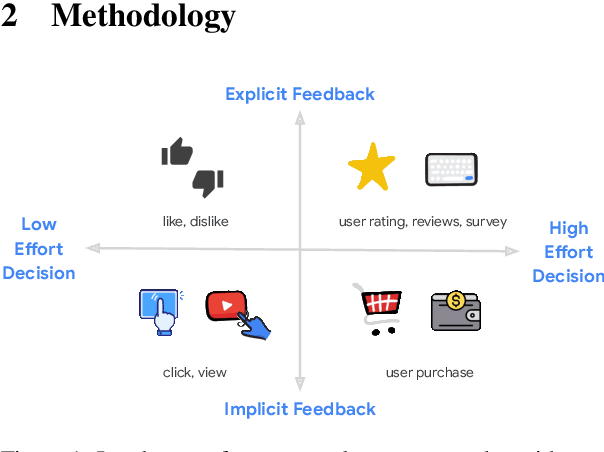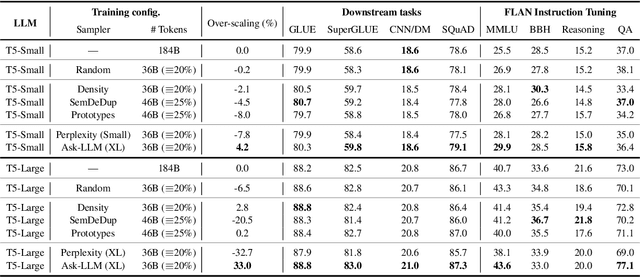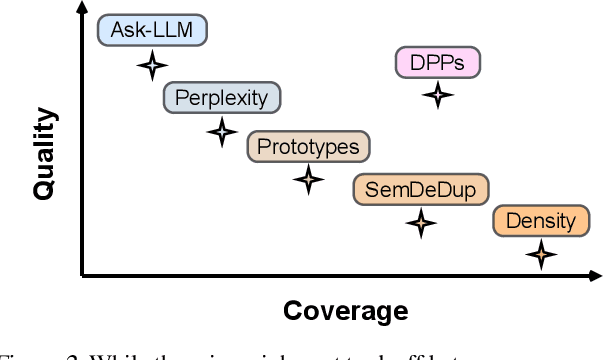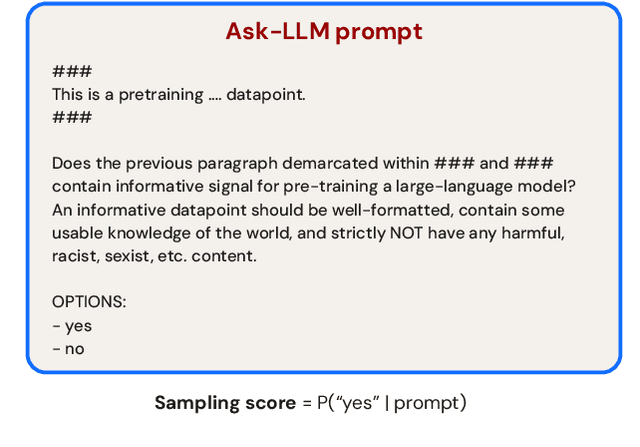Lichan Hong
Jay
User Feedback Alignment for LLM-powered Exploration in Large-scale Recommendation Systems
Apr 07, 2025Abstract:Exploration, the act of broadening user experiences beyond their established preferences, is challenging in large-scale recommendation systems due to feedback loops and limited signals on user exploration patterns. Large Language Models (LLMs) offer potential by leveraging their world knowledge to recommend novel content outside these loops. A key challenge is aligning LLMs with user preferences while preserving their knowledge and reasoning. While using LLMs to plan for the next novel user interest, this paper introduces a novel approach combining hierarchical planning with LLM inference-time scaling to improve recommendation relevancy without compromising novelty. We decouple novelty and user-alignment, training separate LLMs for each objective. We then scale up the novelty-focused LLM's inference and select the best-of-n predictions using the user-aligned LLM. Live experiments demonstrate efficacy, showing significant gains in both user satisfaction (measured by watch activity and active user counts) and exploration diversity.
STAR: A Simple Training-free Approach for Recommendations using Large Language Models
Oct 21, 2024Abstract:Recent progress in large language models (LLMs) offers promising new approaches for recommendation system (RecSys) tasks. While the current state-of-the-art methods rely on fine-tuning LLMs to achieve optimal results, this process is costly and introduces significant engineering complexities. Conversely, methods that bypass fine-tuning and use LLMs directly are less resource-intensive but often fail to fully capture both semantic and collaborative information, resulting in sub-optimal performance compared to their fine-tuned counterparts. In this paper, we propose a Simple Training-free Approach for Recommendation (STAR), a framework that utilizes LLMs and can be applied to various recommendation tasks without the need for fine-tuning. Our approach involves a retrieval stage that uses semantic embeddings from LLMs combined with collaborative user information to retrieve candidate items. We then apply an LLM for pairwise ranking to enhance next-item prediction. Experimental results on the Amazon Review dataset show competitive performance for next item prediction, even with our retrieval stage alone. Our full method achieves Hits@10 performance of +23.8% on Beauty, +37.5% on Toys and Games, and -1.8% on Sports and Outdoors relative to the best supervised models. This framework offers an effective alternative to traditional supervised models, highlighting the potential of LLMs in recommendation systems without extensive training or custom architectures.
Bridging the Gap: Unpacking the Hidden Challenges in Knowledge Distillation for Online Ranking Systems
Aug 26, 2024Abstract:Knowledge Distillation (KD) is a powerful approach for compressing a large model into a smaller, more efficient model, particularly beneficial for latency-sensitive applications like recommender systems. However, current KD research predominantly focuses on Computer Vision (CV) and NLP tasks, overlooking unique data characteristics and challenges inherent to recommender systems. This paper addresses these overlooked challenges, specifically: (1) mitigating data distribution shifts between teacher and student models, (2) efficiently identifying optimal teacher configurations within time and budgetary constraints, and (3) enabling computationally efficient and rapid sharing of teacher labels to support multiple students. We present a robust KD system developed and rigorously evaluated on multiple large-scale personalized video recommendation systems within Google. Our live experiment results demonstrate significant improvements in student model performance while ensuring consistent and reliable generation of high quality teacher labels from a continuous data stream of data.
Leveraging LLM Reasoning Enhances Personalized Recommender Systems
Jul 22, 2024



Abstract:Recent advancements have showcased the potential of Large Language Models (LLMs) in executing reasoning tasks, particularly facilitated by Chain-of-Thought (CoT) prompting. While tasks like arithmetic reasoning involve clear, definitive answers and logical chains of thought, the application of LLM reasoning in recommendation systems (RecSys) presents a distinct challenge. RecSys tasks revolve around subjectivity and personalized preferences, an under-explored domain in utilizing LLMs' reasoning capabilities. Our study explores several aspects to better understand reasoning for RecSys and demonstrate how task quality improves by utilizing LLM reasoning in both zero-shot and finetuning settings. Additionally, we propose RecSAVER (Recommender Systems Automatic Verification and Evaluation of Reasoning) to automatically assess the quality of LLM reasoning responses without the requirement of curated gold references or human raters. We show that our framework aligns with real human judgment on the coherence and faithfulness of reasoning responses. Overall, our work shows that incorporating reasoning into RecSys can improve personalized tasks, paving the way for further advancements in recommender system methodologies.
Aligning Large Language Models with Recommendation Knowledge
Mar 30, 2024



Abstract:Large language models (LLMs) have recently been used as backbones for recommender systems. However, their performance often lags behind conventional methods in standard tasks like retrieval. We attribute this to a mismatch between LLMs' knowledge and the knowledge crucial for effective recommendations. While LLMs excel at natural language reasoning, they cannot model complex user-item interactions inherent in recommendation tasks. We propose bridging the knowledge gap and equipping LLMs with recommendation-specific knowledge to address this. Operations such as Masked Item Modeling (MIM) and Bayesian Personalized Ranking (BPR) have found success in conventional recommender systems. Inspired by this, we simulate these operations through natural language to generate auxiliary-task data samples that encode item correlations and user preferences. Fine-tuning LLMs on such auxiliary-task data samples and incorporating more informative recommendation-task data samples facilitates the injection of recommendation-specific knowledge into LLMs. Extensive experiments across retrieval, ranking, and rating prediction tasks on LLMs such as FLAN-T5-Base and FLAN-T5-XL show the effectiveness of our technique in domains such as Amazon Toys & Games, Beauty, and Sports & Outdoors. Notably, our method outperforms conventional and LLM-based baselines, including the current SOTA, by significant margins in retrieval, showcasing its potential for enhancing recommendation quality.
Wisdom of Committee: Distilling from Foundation Model to Specialized Application Model
Feb 27, 2024Abstract:Recent advancements in foundation models have yielded impressive performance across a wide range of tasks. Meanwhile, for specific applications, practitioners have been developing specialized application models. To enjoy the benefits of both kinds of models, one natural path is to transfer the knowledge in foundation models into specialized application models, which are generally more efficient for serving. Techniques from knowledge distillation may be applied here, where the application model learns to mimic the foundation model. However, specialized application models and foundation models have substantial gaps in capacity, employing distinct architectures, using different input features from different modalities, and being optimized on different distributions. These differences in model characteristics lead to significant challenges for distillation methods. In this work, we propose creating a teaching committee comprising both foundation model teachers and complementary teachers. Complementary teachers possess model characteristics akin to the student's, aiming to bridge the gap between the foundation model and specialized application models for a smoother knowledge transfer. Further, to accommodate the dissimilarity among the teachers in the committee, we introduce DiverseDistill, which allows the student to understand the expertise of each teacher and extract task knowledge. Our evaluations demonstrate that adding complementary teachers enhances student performance. Finally, DiverseDistill consistently outperforms baseline distillation methods, regardless of the teacher choices, resulting in significantly improved student performance.
How to Train Data-Efficient LLMs
Feb 15, 2024



Abstract:The training of large language models (LLMs) is expensive. In this paper, we study data-efficient approaches for pre-training LLMs, i.e., techniques that aim to optimize the Pareto frontier of model quality and training resource/data consumption. We seek to understand the tradeoffs associated with data selection routines based on (i) expensive-to-compute data-quality estimates, and (ii) maximization of coverage and diversity-based measures in the feature space. Our first technique, Ask-LLM, leverages the zero-shot reasoning capabilities of instruction-tuned LLMs to directly assess the quality of a training example. To target coverage, we propose Density sampling, which models the data distribution to select a diverse sample. In our comparison of 19 samplers, involving hundreds of evaluation tasks and pre-training runs, we find that Ask-LLM and Density are the best methods in their respective categories. Coverage sampling can recover the performance of the full data, while models trained on Ask-LLM data consistently outperform full-data training -- even when we reject 90% of the original dataset, while converging up to 70% faster.
LEVI: Generalizable Fine-tuning via Layer-wise Ensemble of Different Views
Feb 07, 2024



Abstract:Fine-tuning is becoming widely used for leveraging the power of pre-trained foundation models in new downstream tasks. While there are many successes of fine-tuning on various tasks, recent studies have observed challenges in the generalization of fine-tuned models to unseen distributions (i.e., out-of-distribution; OOD). To improve OOD generalization, some previous studies identify the limitations of fine-tuning data and regulate fine-tuning to preserve the general representation learned from pre-training data. However, potential limitations in the pre-training data and models are often ignored. In this paper, we contend that overly relying on the pre-trained representation may hinder fine-tuning from learning essential representations for downstream tasks and thus hurt its OOD generalization. It can be especially catastrophic when new tasks are from different (sub)domains compared to pre-training data. To address the issues in both pre-training and fine-tuning data, we propose a novel generalizable fine-tuning method LEVI, where the pre-trained model is adaptively ensembled layer-wise with a small task-specific model, while preserving training and inference efficiencies. By combining two complementing models, LEVI effectively suppresses problematic features in both the fine-tuning data and pre-trained model and preserves useful features for new tasks. Broad experiments with large language and vision models show that LEVI greatly improves fine-tuning generalization via emphasizing different views from fine-tuning data and pre-trained features.
Hiformer: Heterogeneous Feature Interactions Learning with Transformers for Recommender Systems
Nov 10, 2023



Abstract:Learning feature interaction is the critical backbone to building recommender systems. In web-scale applications, learning feature interaction is extremely challenging due to the sparse and large input feature space; meanwhile, manually crafting effective feature interactions is infeasible because of the exponential solution space. We propose to leverage a Transformer-based architecture with attention layers to automatically capture feature interactions. Transformer architectures have witnessed great success in many domains, such as natural language processing and computer vision. However, there has not been much adoption of Transformer architecture for feature interaction modeling in industry. We aim at closing the gap. We identify two key challenges for applying the vanilla Transformer architecture to web-scale recommender systems: (1) Transformer architecture fails to capture the heterogeneous feature interactions in the self-attention layer; (2) The serving latency of Transformer architecture might be too high to be deployed in web-scale recommender systems. We first propose a heterogeneous self-attention layer, which is a simple yet effective modification to the self-attention layer in Transformer, to take into account the heterogeneity of feature interactions. We then introduce \textsc{Hiformer} (\textbf{H}eterogeneous \textbf{I}nteraction Trans\textbf{former}) to further improve the model expressiveness. With low-rank approximation and model pruning, \hiformer enjoys fast inference for online deployment. Extensive offline experiment results corroborates the effectiveness and efficiency of the \textsc{Hiformer} model. We have successfully deployed the \textsc{Hiformer} model to a real world large scale App ranking model at Google Play, with significant improvement in key engagement metrics (up to +2.66\%).
Talking Models: Distill Pre-trained Knowledge to Downstream Models via Interactive Communication
Oct 04, 2023Abstract:Many recent breakthroughs in machine learning have been enabled by the pre-trained foundation models. By scaling up model parameters, training data, and computation resources, foundation models have significantly advanced the state-of-the-art in many applications. However, it is still an open question of how to use these models to perform downstream tasks efficiently. Knowledge distillation (KD) has been explored to tackle this challenge. KD transfers knowledge from a large teacher model to a smaller student model. While KD has been successful in improving student model performance, recent research has discovered that a powerful teacher does not necessarily lead to a powerful student, due to their huge capacity gap. In addition, the potential distribution shifts between the pre-training data and downstream tasks can make knowledge transfer in KD sub-optimal for improving downstream task performance. In this paper, we extend KD with an interactive communication process to help students of downstream tasks learn effectively from pre-trained foundation models. Our design is inspired by the way humans learn from teachers who can explain knowledge in a way that meets the students' needs. Specifically, we let each model (i.e., student and teacher) train two components: (1) an encoder encoding the model's hidden states to a message and (2) a decoder decoding any messages to its own hidden states. With encoder and decoder, not only can the teacher transfer rich information by encoding its hidden states, but also the student can send messages with information of downstream tasks to the teacher. Therefore, knowledge passing from teacher to student can be tailored to the student's capacity and downstream tasks' distributions. We conducted experiments on benchmark datasets to show that our communication mechanism outperforms state-of-the-art distillation techniques.
 Add to Chrome
Add to Chrome Add to Firefox
Add to Firefox Add to Edge
Add to Edge